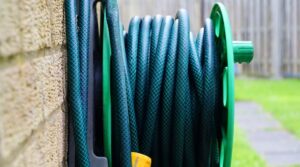A garden is a lively place at this time of year. While some plants are coming to the end of the season, others for whom the season is just beginning! This is part of the joy of the garden. The glorious seasonal change keeps things colorful and beautiful for the year. Garden maintenance takes many forms – weeding is one, clearing away debris another. Most likely, you will have a set of garden tools you use regularly. One of the most important is the garden hose, and implement that has been around for as long as gardens have been tended.
You may think the garden hose is a standard item. This is not the case, as there are many different hoses to choose from. For a start, you need to consider the length of the hose you need. This will be determined by the size of your yard or garden. Then there’s the water pressure and output that the hose can handle. Historically, garden hoses have been made from rubber or plastic – or some form of each – and there have been pitfalls with these that we need to talk about! Before we move on, here’s a handy guide to gardening tips for fall so you can refresh your memory as to what needs doing.
Common Problems with Garden Hoses
You can inadvertently cause the most damage by failing to reel snugly after use.
Not reeling up the hose after use
Garden hoses are made from far better materials now that production methods have been improved. In general, your average garden hose will last many years if kept carefully, without any problems. But there are some things that can go wrong. If you have dogs, they may enjoy playing with your garden hose when you’re not looking! When you come to turn it on, you’ll find it has plenty of holes in it, and water goes everywhere!
This is quite a common problem with household pets around. What’s the answer? Ensure your hose is correctly stored on a reel for ease of use. This also means you can pick it up and put it away, out of the way of the dogs. Another problem is that of the hose becoming brittle. This is something that happens over time – although your hose really should last at least five years – and results in cracks appearing in the hose and lack of pressure as a result. You can try and patch the hose, but it is really time to buy a new one at this point.
Kinks that creates a rupture point
One further problem is the dreaded ‘kink.’ This occurs when the hose doubles back on itself, creating a fold in the material and stopping any water coming through. It is at this point that you can experience a burst. You turn on the hose, are unaware of the kink, and the water in your hose builds up quickly behind it a ruptures the hose, resulting in permanent damage and a loss of a lot of water. This can be avoided by storing the hose correctly – not wound too tightly, or this can encourage kinks – or buying a hose that is made from reinforced rubber.
In truth, burst hoses are not a common occurrence as hoses are designed to operate to a certain bust pressure rating.
 What is Burst Pressure?
What is Burst Pressure?
The Burst Pressure rating is the point at which your hose is taking the maximum pressure it possibly can. This is set by the construction and size of the hose, as well as other factors. It is important because high pressures are needed for some uses. Besides, not all hoses can operate to the highest levels of pressure. So what rating should you be looking for?
A standard garden hose should come with a burst pressure rating of no less than 250psi. This will be enough to achieve a high-pressure spray for your garden and standard jobs you might want to use your hose for. However, when you are looking for a high-pressure hose, you should look for one with a burst pressure of 350psi or greater. Some more advanced hoses can handle up to 600psi. But it’s doubtful you would need such high pressure for general gardening routines. Check the pressure when you are comparing hoses to be certain you are buying one that will do the job you do most often.
When choosing a hose, always look at the diameter of the tubing itself; this can vary, and many gardeners find the smaller yet common 7/16” hose to be too small. Also, look for one that is not too stiff. There is no such thing as a no-kink hose. But you can find some that are designed to do all they can to prevent kinking – and not too soft. Check known brands as there is a reason these are popular, and you should have little trouble finding the right hose.
So now it’s time to get out in the garden and prepare for the fall – we hope you enjoy it!


